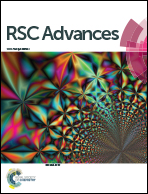Highly selective and sensitive simultaneous nanomolar detection of Cs(i) and Al(iii) ions using tripodal organic nanoparticles in aqueous media: the effect of the urea backbone on chemosensing†
Abstract
Chemosensing plays a very important role in the detection of essential/pollutant ions in aqueous media. In this manuscript, two tripodal ligands, i.e., 1-(2-hydroxybenzyl)-3-(4-nitrophenyl)-1-phenylurea (ligand 1) and 1-(2-hydroxybenzyl)-3-(4-nitrophenyl)-1-phenylthiourea (ligand 2) have been synthesised, which differ in the linker molecule, i.e., urea and thiourea in ligand 1 and ligand 2, respectively. The ligands were characterised by NMR, IR and mass spectroscopic techniques. Ligands 1 and 2 (2 mM) were further employed for the generation of their organic nanoparticles (ONPs) (0.01 mM) of size 20–25 nm and 30–35 nm, respectively, by the reprecipitation method. The chemosensing properties of 1-ONP and 2-ONP solutions were investigated. 1-ONP showed simultaneous recognition behaviour towards Cs(I) and Al(III) with the limits of detection of ∼220 and ∼377 nM, respectively, in an aqueous medium, while 2-ONP did not show any recognition behaviour towards any ion.



 Please wait while we load your content...
Please wait while we load your content...